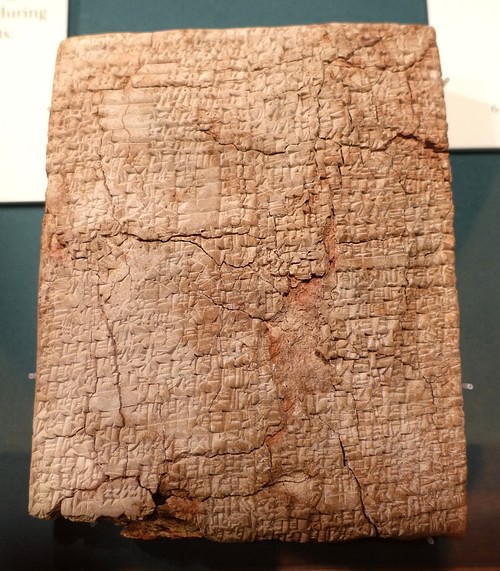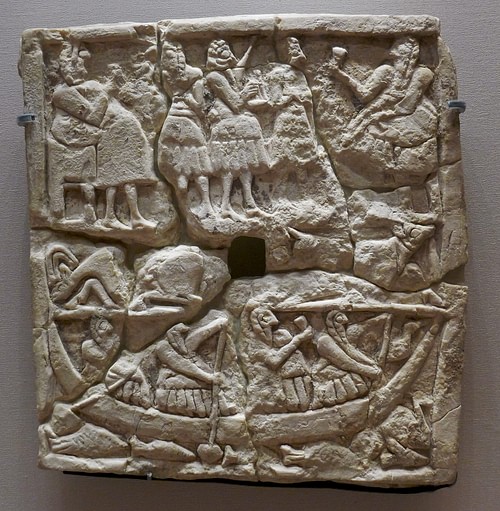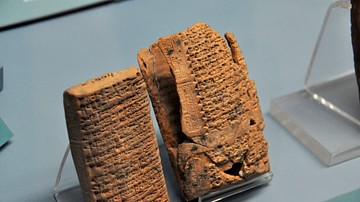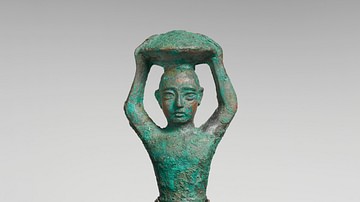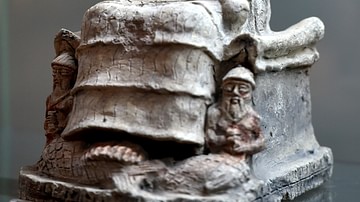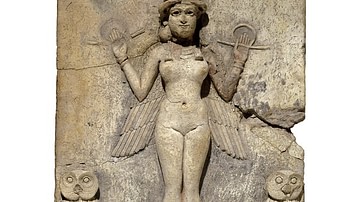Shulgi and Ninlil's Barge is a Sumerian poem dated to the reign of Shulgi of Ur (2029-1982 BCE) celebrating the caulking of the barge of the goddess Ninlil, consort of the sky god Enlil, and the banquet held in the couple's honor by Shulgi who is then blessed by Ninlil with the promise of a prosperous reign.
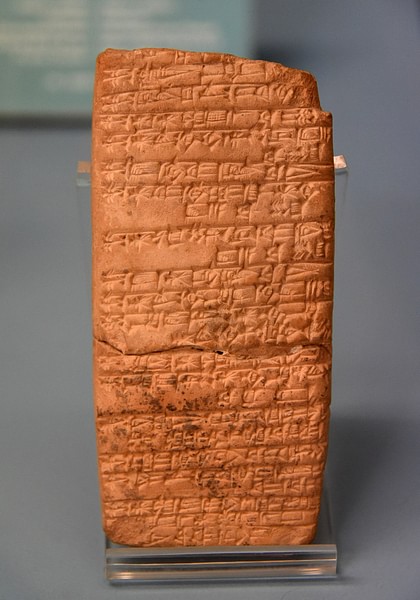
The title is a modern designation, as is the case with many works of Mesopotamian literature, and the original, if a title was given, has been lost. The poem commemorates the historical event, in the eighth year of Shulgi's reign, given in his inscriptions as the "Year in which Ninlil's barge was caulked" and describes the barge, the river journey to the sacred site of Tummal, just below the city of Nippur (also known as Nibru), the nighttime banquet, and return to Nippur the next morning.
Nippur was a sacred city, chiefly associated with the cult of Enlil and, by association, Ninlil. By the time of Shulgi's reign, the city had become an important pilgrimage site; as had nearby Tummal. The kings of the Ur III Period (2047-1750 BCE), including Shulgi, claimed their authority derived from Enlil and Ninlil, and so observances honoring the divine couple were of special importance. Shulgi's father, Ur-Nammu (r. 2047-2030 BCE), understood the political significance of honoring the gods to win the goodwill of the people, and Shulgi continued his policies, as would his successors, especially concerning religious festivals.
The poem (also known as Shulgi R) was discovered in the ruins of Nippur in the mid-19th century and was most likely among the many used in the scribal schools of the city. The work only exists in a damaged form, the cuneiform tablet fractured in places, but still conveys the importance of the event while vividly depicting travel by boat on the Tigris and Euphrates rivers in ancient Mesopotamia. The work is frequently anthologized in the present day and remains a favorite among Mesopotamian literary works.
Shulgi of Ur
Shulgi of Ur was the second king of the Ur III Dynasty founded by Ur-Nammu, and the Ur III Period is often referenced as the Sumerian Renaissance as some scholars claim it saw the rebirth of Sumerian art and culture following the Gutian Period (2218-2047 BCE) when the region was occupied by foreign invaders. The Gutians, according to later Sumerian scribes, toppled the Akkadian Empire (2334-2218 BCE), which had conquered the Sumerian city-states, and the Ur III kings then revived the pre-Akkadian Sumerian culture (though this interpretation has been challenged by some scholars). Shulgi of Ur, according to his inscriptions, was mainly responsible for this revival.
Ur-Nammu died in battle with the Gutians, and, afterwards, Shulgi took up the cause, driving the invaders from Sumer and avenging his father's death. He then initiated policies to improve the infrastructure, boost trade and the economy, and encourage literacy through the establishment of more scribal schools throughout his kingdom. He either maintained or issued the famous Code of Ur-Nammu, his father's law code, and is thought to be the first to establish roadside inns with landscaped gardens while also standardizing weights and measures, time, and the calendar to unify the cities throughout his territory.
An important aspect of this unity, he seems to have realized, was portraying himself to the people as Ur-Nammu had done: as a father figure who would serve as a role model in every respect and, notably, in regards to religious piety. Shulgi is best known for his famous run from Nippur to Ur (a distance of 100 miles/160.9 km) to officiate at Ur's religious festival, and then running back from Ur to Nippur to perform the same function there, covering a distance of 200 miles (321.8 km) on foot in a single day, an event commemorated in A Praise Poem of Shulgi.
As his authority as king was claimed to derive from Enlil and Ninlil, he paid special attention to their city of Nippur, and, in the eighth year of his reign, had the barge of Ninlil outfitted and caulked for river travel and honored her and Enlil with a trip downriver, a banquet, and a return to their home in the temple at Nippur. Scholar Jeremy Black comments:
Just as the gods lived in houses (temples) and were fed and provided with furniture and clothes, so some of them also had ceremonial barges on which their statues were transported for festivals. In this case, Shulgi has a barge built for the goddess Ninlil, and has her and other deities transported on an overnight trip to a location near Nippur where a banquet is held. Such splendid ceremonial progresses were a feature of the cultic life of the Third Dynasty of Ur and, to a lesser extent, of its successor dynasties. (113)
Shulgi's show of respect for the gods was continued by his younger son (or, according to some scholars, grandson), Shu-Sin (r. 1973-1964 BCE), who also had a barge constructed in honor of Ninlil and performed the same ritual in the eighth year of his reign. These ritual acts were observed, not only to pay homage to the gods but also as a means of uniting the people in religious belief – as all Mesopotamian religious festivals were designed to do – as the monarch was clearly sending the message that if he, with all his responsibilities, could take the time to properly honor the gods, his subjects could certainly do the same.
Summary & Commentary
The poem is comprised of two sections, each marked at their conclusion, respectively, as a sa-gida and sa-gara, both terms for musical notations which, according to scholar Shail Vyas, are thought to have derived from similar words (sadja=sa-gida/svara=sa-gara) of the Indus Valley Civilization (13). The sa-gida section (lines 1-39) speaks directly to the barge while describing it, and the sa-gara section provides the story of the trip from Nippur to Tummal, the banquet, the return the next morning, and the blessing of Ninlil.
The poem was almost certainly sung and, as Black notes, "we can assume that the song was publicly performed at some ceremonial occasion associated with the festival" (113). The sa-gida would have been sung to praise the barge itself; the sa-gara to immortalize and commemorate the event. Together, they would have been sung to honor Ninlil and Enlil specifically but also the other gods mentioned in the work – Enki, Nanna, and Ninurta – whose statues would have been brought on board along with those of the divine couple.
Although Enlil is commonly depicted as one of the most powerful gods, frequently associated with the sky god An (Anu), Ninlil enjoyed nearly equal prestige and, in some stories, is depicted as more powerful than either Enlil or Anu as she was responsible for determining fate. In that capacity, she was consulted by the gods before decisions were made and honored by monarchs with special attention in hopes she would look upon them kindly and support their reign.
In the poem, after Ninlil has been taken on the journey to her sacred site at Tummal, feasted, and returned to Nippur, she responds precisely as Shulgi, or any other king, would have hoped. Lines 82-90 conclude the work as Ninlil, "with joyful eyes and shining forehead", looks upon Shulgi and blesses him with a long reign.
Text
The following is taken from The Literature of Ancient Sumer translated by Jeremy Black et al. and from the Electronic Text Corpus of Sumerian Literature, translated by the same. Ellipses indicate missing lines or words while question marks suggest alternate translations for a word or phrase.
1-9: Oh barge, Enki assigned the quay of abundance to you as your fate. Father Enlil looked at you with approval. Your lady, Ninlil, commanded your construction. She entrusted it to the faithful provider, king Shulgi; and the shepherd, who is of broad intelligence and who will not rest day and night in thinking deeply about you. He, the wise one, who is proficient in planning, he, the omniscient one, will fell large cedars in the huge forests for you. He will make you perfect and you will be breathtaking to look upon.
10-22: Your woven ... is ... Your covering reed-mats are the daylight spreading wide over the holy settlements. Your timbers are sniffing (?) ... reptiles crouching on their paws. Your punting poles are dragons sleeping a sweet sleep in their lair. Your strakes (?) are ... snakes, ... Your floor-planks are flood-currents, sparkling altogether in the pure Euphrates. Your side-planks, which are fastened into their fixed places (?) with wooden rings (?), are a stairway leading to a mountain spring (?), a ... filled with ... Your holy ... are persisting and firmly founded abundance. Your bench is a lofty dais erected in the midst of the abzu. Your ... is Aratta, full-laden with treasures. Your door, facing the sunrise, is a ... bird, carrying a ... in its talons while spreading wide its wings.
23-31: Your glittering golden sun-disc, fastened with leather straps, is the brilliant moonlight, shining brightly upon all the lands. Your banner, adorned with the divine powers of kingship, is a woodland of cypress trees irrigated with clean water, giving a pleasant shade. Your small reed mats are the evening sky, illuminated with stars, imbued with terrible awesomeness. In the midst of your carefully tended small gizi reeds with numerous twigs (?), swarms of birds twitter as in a holy swamp. Their chirping, as pleasing to the heart as the sound of the churn's shaking, makes Enlil and Ninlil extremely happy (?).
32-39: Your rudder is a large kij fish in the broad waters at the mouth of the Kisala canal. Your ... are a bison, inspiring terror on the great earth. Your tow-rope is the gliding Nirah extended over the land. Your mooring pole is the heavenly bond, which ... Your longside beams are a warrior striking straight against another warrior. Your prow is Nanna ... fair sky. Your stern is Utu ... at the horizon. Your hold (?) is ...
40: Sa-gida.
41-47: The faithful shepherd Shulgi established the holy festival and the great rituals. The great gods bathe in holy water in Nippur. He assigns the fates to their places in the city and allocates the right divine powers. The mother of the Land, Ninlil the fair, comes out (?) from the house, and Enlil embraces her like a pure wild cow. They take their seats on the barge's holy dais, and provisions are lavishly prepared.
48-63: The lofty barge ..., the ornament of the Tigris, enters the rolling river; ... on the shining water. The ritually washed five-headed mace, mitum mace, lance and standard ... at the bow. Enlil's warrior, Ninurta, goes at their front, directing the ... of your wide ferryboat (?) straight. He ... the holy punting pole of the barge, the holy raft. The ferrymen (?) ... holy songs; they (?) ... the great exaltedness of the lady. The good woman, Ninlil, ... joyfully with (?) Shulgi. Sumer and Uruk ... joy and happiness. The barge bobs at the quay Mete-aji (Ornament of the waves); it sails off into the reed-beds of Enlil's Tummal. Like a goring (?) ox, it raises, then lowers its head. It strikes its breast against the rising waves; it stirs up (?) the encircling waters. When it thrusts within the waters, the fishes of the subterranean waters become frightened; as it glides (?) upon them, it makes the waters sparkle (?) luxuriantly.
64-70: ... the holy raft; ... the lady of Tummal ... prayer. Enlil's ancestors and An the king, the god who determines the fates, greets her. With Ninlil, they take their seats at the banquet, and Shulgi the shepherd brings along his great food-offerings for them. They pass the day in abundance; they give praise throughout night. They decree a fate, a fate to be pre-eminent forever, for the king who fitted out the holy barge.
71-81: Then light shines up at the edge of the Land as Utu rises refulgently. As the barge is travelling upstream, it ... radiates (?) and creaks (?). ... in the Ninmutum, the canal of the year of abundance ... As the carp make their bellies (?) sparkle, Enlil rejoices. As the mucu fish play noisily there, Ninlil rejoices. As the ... fish ..., Enki rejoices. As the cuhurmac fish dart about, Nanna rejoices. The Anuna gods rejoice at ... ... lifts its head in the Euphrates; it ... In the midst of ... ever-flowing water is carried. In joyous Nippur, he moors the holy barge at the quay.
82-90: With joyful eyes and shining forehead, Ninlil, ..., looks upon king Shulgi: "Shepherd ..., Shulgi, who has a lasting name, king of jubilation! I will prolong the nights of the crown that was placed upon your head by holy An, and I will extend the days of the holy sceptre that was given to you by Enlil. May the foundation of your throne that was bestowed on you by Enki be firm! Shepherd who brings about perfection, may Nanna, the robust calf, the seed of Enlil, to whom I gave birth, cover your life with ... which is full of exuberance as if it were my holy ma garment!"
91: Sa-gara.
Conclusion
Festivals in ancient Mesopotamia were grand celebrations of the gifts of the gods and, as noted, were staged by the kings to unify their subjects. The event recorded as the "Year in which Ninlil's barge was caulked" would have been commemorated with later festivals at which Shulgi and Ninlil's Barge would have most likely been performed. These events would have not only immortalized Shulgi's name as a pious king but associated the kingship generally with acts of piety while continuing to honor the deities mentioned in the work and, by extension, all the gods. Scholar Stephen Bertman comments:
The greatness of the gods and their manifold blessings were celebrated on special holy days and festivals. The most important of these sacred occasions in a community honored its local god, who was its patron and protector. But on a larger scale across their country, the people of Mesopotamia also expressed their gratitude in common for the fertility of their land whose bounty sustained their lives and derived from divine favor. (130)
By honoring the gods, the people ensured their continued prosperity and, in the case of the king, the stability of his reign. At the end of the poem, when Ninlil blesses Shulgi, the work is not only making clear that his specific act of piety has been rewarded but also that future kings should follow his example if they hoped to reign securely. As a king's position of authority depended upon the gods looking favorably upon his stewardship of the land and its people, taking the time to offer them a change of scenery and a banquet was simply an act of common sense, and based on their inscriptions, Shulgi's successors took the poem's final message to heart.
